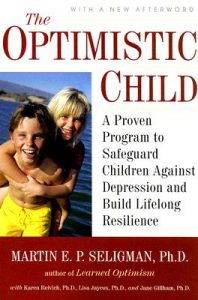 When my children were young, I embraced a wide array of books for guidance and inspiration.
When my children were young, I embraced a wide array of books for guidance and inspiration.
One of my favorites – The Optimistic Child by Martin Seligman – has shaped simple daily practices far beyond my role as a parent.
So it was a wonderful opportunity a couple years ago when I attended the Aspen Ideas Festival and had the opportunity to hear Seligman sharing a session with Matthieu Ricard, a French Buddhist monk who has also written extensively.
In this newsletter, I share their recommendations for improving your day-to-day authentic well-being.
I hope they are as meaningful for you as they have been for me.
A new theory of well-being
Seligman – often called the father of positive psychology – is the Zellerbach Family Professor of Psychology at the University of Pennsylvania, and has served as director of the university’s Positive Psychology Center.
A best-selling author, he has devoted his career to examining the opposite of what many psychologists traditionally study – not what can go wrong, but rather, what can go right—positive emotions, character traits, and institutions.
His perspective: Many people feel they are powerless to change situations – but they have more opportunity than they think.
Got PERMA?
With a foundation of belief in the value of the positive, Seligman defines authentic well-being with several dimensions, using the acronym PERMA. It stands for:
Positive emotion
Engagement
Good Relationships,
Meaning and purpose, and
Achievement or accomplishment.
With intentional effort, we can increase our PERMA, he says, with practices that are evidence-based.
In the preface to his latest book, Flourish, Seligman says, “I am a research scientist, and a conservative one at that. The appeal of what I write comes from the fact that it is grounded in careful science: statistical representative samples. In contrast to pop psychology and the bulk of self-improvement, my writings are believable because of the underlying science.”
And that’s why his suggested practices are credible to me, and, I hope, to you as well.
Seligman shared four of his key practices with us at Aspen:
1. The What Went Well Exercise (Improves Positive Emotion): Our natural focus is on the negative events in life; and there is certainly benefit in learning from bad experiences. But focusing on the negative increases anxiety. This exercise strengthens your ability to discern and hold tight to what is going well. For a week, before sleep, write down 3 things that went well and why. Actually writing or typing it is important. Next to each put a place to answer: “Why did this happen?” Do it for a week even if it feels awkward. By the time you are finished, you may eventually find it addictive.
2. The Signature Strengths Exercise (Improves Engagement): To do this practice requires knowing your signature strengths. You can complete the assessment that will give you that information at this link. You register for free and go through a series of questions online for the Via Survey of Character Strengths. When I took the test today, it took about 30 minutes.
Now think of something you do every day that you don’t particularly like to do – and approach that thing you don’t like to do using a signature strength. Here’s an example: One of Seligman’s graduate students had a job she didn’t like – bagging groceries. One of her signature strengths was social intelligence. So she added this exercise when she bagged – connecting with each customer with the goal of making an interaction with her their best moment of the day.
3. The Gratitude Visit (Improves good Relationships) Close your eyes and think of someone who years ago did or said something that improved your life. This needs to be someone who is still alive. Now, write a 300-word testimonial – what she did, how it affected you at the time, and how it affects you today.
Then call and make a plan to visit, but don’t say why. When you visit, read them the letter. Seligman – who sees gratitude very closely correlated with happiness – says people who did gratitude visits were less depressed and had a greater sense of well-being one month later.
4. Active Constructive Responding (Improves Relationships) Seligman said marriage counseling is often the worst kind of therapy – because it focuses on teaching people to fight better. Dr. Shelly Gable of University of California Santa Barbara looked instead at how married couples celebrated together and found how they celebrate is more predictive of good relationships than how they fight.
So how we help others celebrate can be a powerful means for improving relationships.
Here’s an example: When someone tells us of a good thing that has happened to them, we can respond in an active or passive way, a constructive or destructive fashion. When your spouse comes home and tells you he or she was promoted, an active destructive response is “Do you know what tax bracket that will put us in?” Passive destructive is “What’s for dinner?”
An active, constructive response has the greatest positive impact: “What great news! Let’s relive that moment. Where were you? What did he say? How did you react? We should go celebrate.”
So the practice is, for a week, listen carefully each time someone shares good news. Go out of your way to respond in an active constructive way. The key is to help the person relive the positive event or emotion.
Seligman noted that this is another self-maintaining practice, but it is not one that comes naturally to most of us. Intentional practice will help you become better at this practice with double benefit – “People like you better, they spend more time with you, and they share more of the intimate details of their lives. You feel better about yourself, and all this strengthens the skill of active, constructive responding.”
To learn more about Seligman’s latest research, check out this website with free assessments, articles, and information.
Well-being from the inside out
Matthieu Ricard’s comments came from his experiences as a Buddhist monk for 40 years. But Ricard was trained as a biochemist, writes, creates art and is a photographer. An author, his proceeds go to support humanitarian causes.
Happiness that comes from outside can provide pleasure, he said, but true well-being comes from inside. So we are not talking about the thrill of buying a new car or a new designer handbag, but rather altruistic love, inner peace and inner strength that create a deep reservoir of well-being. You can experience sadness, he says, and still have genuine well-being as your foundation.
Some people try to build a bubble of self centeredness, thinking “I will focus on my own happiness,” Ricard said. But that doesn’t work because usually your failures as well as your successes get magnified. You feel miserable and are miserable with others. This approach is dysfunctional because it is at odds with reality — genuine happiness comes through our connections with others.
The meditative state that brings the most positive result is compassion, he said: It exists in harmony with reality. It recognizes the fundamental motivation of all to avoid suffering and seek happiness. Genuine happiness is not a reward for good behavior; it is a result of living a compassionate life. We have a biological urge to care, and we can extend that through training.
It takes practice
We know that high levels of skill require persistence and practice. We can’t get kindness and compassion without that same kind of practice.
Ricard suggested the following exercise to build compassion and therefore authentic well-being: Sometimes we have magic moments. So, he says, focus in on what made them special. Tune into the feelings you experienced in that moment – harmony, no inner conflicts…. then, cultivate those feelings. As a starting point for practice, recall a genuine moment of unconditional love, like you have for a child. Matthieu said, “That feeling has a different fragrance. Identify those qualities, then don’t let it go. Hang on to it – bring it to mind, keep it there. If it goes, bring it back, in a clear, stable, and vivid way. Maintain it. If you do regularly it will become part of yourself.”
Do this practice every day expecting genuine gradual change.
Want to learn more?
Both Seligman and Ricard have been active presenters at TED conferences in recent years. Here are a couple links:
Seligman on The new era of positive psychology
Ricard on The Habits of Happiness
Books by Martin Seligman
Flourish: A Visionary New Understanding of Happiness and Well-being
Learned Optimism: How to Change Your Mind and Your Life
What Can Change and What You Can’t: The Complete Guide to Self-Improvement
Books by Matthieu Ricard
Happiness: A Guide to Developing Life’s Most Important Skill by Matthieu Ricard and Daniel Goleman
Why Meditate: Working with Thoughts and Emotions
The Monk and the Philosopher: A Father and Son Discuss the Meaning of Life by Jean-Francois Revel, Matthieu Ricard, John Canti and Jack Miles
The Great Medicine That Conquers Clinging to the Notion of Reality: Steps in Meditation on the Enlightened Mind by Shechen Rabjam and Matthieu Ricard


Leave a Reply